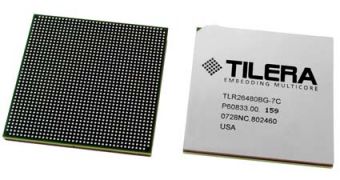A small company from Silicon Valley named Tilera announced a new breed of central processing unit, CPU for short, that comes with no less than 64 processing cores. According to the manufacturing company, the Tile64, as their processor is named can outperform the fastest Intel processor by 10 times, while being 30 times more energy efficient.
The Tile64 processor, apart from integrating 64 programmable cores, comes with an embedded high-speed network dedicated system that can pass 32 terabits of data per second between the various cores. The CPU is designed specifically for networking servers and other equipments like multimedia streaming servers and it can provide up to 10 times the performance of an Intel Xeon processor from the latest generation, according to the news site News.com. The power consumption was regulated too, as the Tile64 CPU makes do with far less power, while producing the same results like almost 40 digital signal processors made by the company Texas Instrument. As the Tilera company seems to hold the secret of free data path between CPU cores, it may very well face a very lucrative business in the near future. As processor speed and capabilities got upgraded year after year, the links between different cores or between the CPU itself and the rest of the computer are now acting as performance bottlenecks.
There are various technologies that are used to address this problem, like the proprietary AMD HyperTransport that is used inside AMD processors, most notably the Athlon generations. "The fundamental limitation of CPUs is no longer (core) performance but I/O (input/output)," Andy Bechtolsheim said in a presentation to reporters in June on Sun Microsystems' efforts in supercomputing. "You don't get more I/O just because you shrink the manufacturing process." The Tilera design of its CPU tries to make the data transfers between the various cores faster, as each core is a RISC unit that runs at speeds between 600MHz and 1GB as well as a switch that can transmit data in all directions. The switches are forming a kind of network named iMesh that is used by the cores to communicate. The entire mesh network is separated into several layers like the one that handles streaming data or the one that goes for the cache-to-cache transfers.
Another new thing is that each core has two caches for rapid access to data and while the caches are physically separated between each other, one tile can access another one's cache. On the power side, energy consumption is low as each core needs between 170 milliwatts to 300 milliwatts on average and any number of tiles can power down when idle.

 14 DAY TRIAL //
14 DAY TRIAL //